Types of Black Spiders (With Pictures) – Identification Guide

Identifying types of black spiders is crucial to tell the difference between harmless black spiders and dangerous ones. For example, the black house spider can bite, but it’s not aggressive nor considered dangerous. However, the black widow spider has a nasty venomous bite causing pain, cramps, and muscle spasms. Most black spiders in the house or garden are relatively harmless and tend to stay away from humans.
Seeing a black spider scurrying across the floor is enough to send anyone into a panic. Even tiny black spiders in the house with their spindly legs and round body can strike fear into anyone. Usually, dangerous black spiders have bright markings as a warning sign. You may also come across black and yellow spiders in your garden. Some furry black spiders have menacing faces and hairy legs and can jump.
This article is a guide to help identify some of the most common types of black spiders you’re likely to encounter at home or in the yard. In addition, descriptions and pictures of black spiders will help to tell harmless spiders apart from poisonous ones.
Facts About Black Spiders
Most people think about the black widow spider when they hear about black spiders. Widow spiders with their black round body and red markings are infamous for their painful bite. However, despite their fearsome reputation, black widows are typically not aggressive, and their bite is rarely deadly.
The most typical black spider you’re likely to come across indoors is the black house spider. This small black or dark brown spider has a plump body and eight fat legs. Like the black widow, the common black spider has a nasty bite that may cause swelling and nausea. However, unlike the black widow, house spiders don’t have thin, spindly legs.
How to Identify Black Spiders
To identify a species of black spider, look for markings on its body and the presence of hairs or spikes on its legs or body. Black spiders belong to the class of arthropods Arachnida. Like all arachnoids, black spiders have eight legs, typically longer than their body, consisting of two segments—a cephalothorax and abdomen.
Types of Black Spiders (With Pictures) – Identification Guide
Let’s look in more detail at identifying the types of black spiders you are likely to encounter.
Black House Spider (Badumna insignis)

Black House Spider (Badumna insignis)
The black house spider is a robust but small black spider with a wide body, relatively fat legs, and dark charcoal-gray body. Like many spider types, the female spider is larger than the male. Both sexes have light markings, and their dark bodies are covered in fine, velvety hairs.
Female black house spiders grow 0.7” (1.8 cm) long with a leg span of 1.1” (3 cm). Common house spiders have a poisonous bite but are not aggressive or dangerous. A black house spider bite usually causes pain and local swelling.
Common black house spiders typically live in wall crevices, window frames, or corners of doorways. Outdoors, the small black spiders live under woodpiles and in rough-barked trees.
Black spider identification: Small black house spiders have a dark gray body with light shading on their abdomens. Black house spiders spin messy webs with a funnel-shaped center where the spiders wait for prey.
Black Widow Spider (Latrodectus spp.)
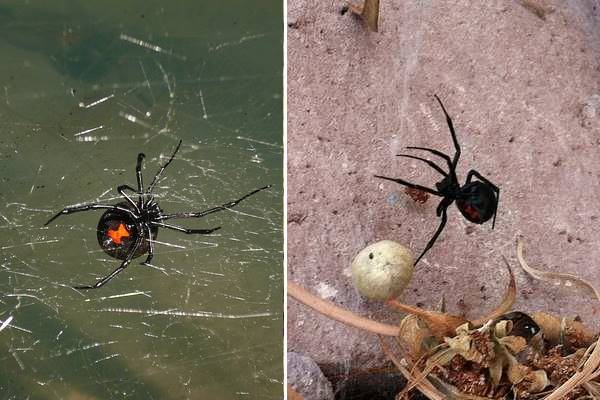
Black Widow Spider (Latrodectus mactans)
The black widow spider is a tiny black spider with a large round abdomen, long spindly legs, and red markings on its underside. To identify a black widow from other black house spiders, look for the distinctive red hourglass markings on the underside of its abdomen.
Black widow spiders are small spiders that grow between 0.1” – 0.4” (0.3 – 1 cm) long. Black widow spiders have a poisonous bite containing neurotoxins that can affect the central nervous system. The black spider bite can cause abdominal cramps, muscle pain, racing heartbeat, and muscle spasms. However, black widow bites rarely cause severe, long-lasting harm.
You’ll typically find black widow spiders under piles of wood, and they usually get into buildings on firewood. Additionally, insects can attract them indoors if the black widows are hungry. The black and red spiders hide in basements, under furniture, in footwear, and crevices in baseboards.
Black spider identification: The black widow spider is easy to identify due to its shiny black body, red markings, and legs longer than its body. Black widow webs are irregular and tangled and consist of several layers.
Redback Spider (Latrodectus hasselti)
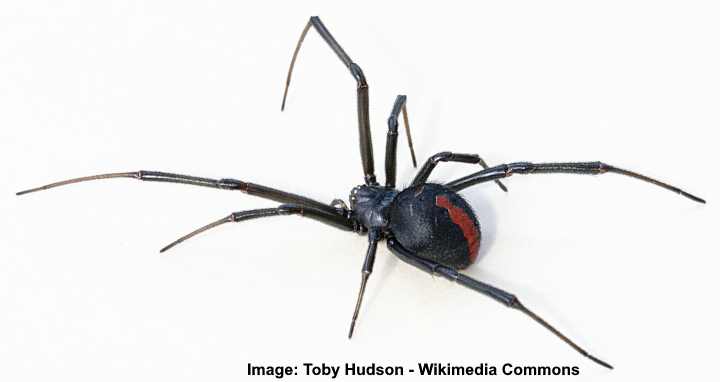
Redback Spider (Latrodectus hasselti)
As the name implies, this tiny black spider has red markings on its rounded abdomen. The redback spider is in the same genus as the black widow spider. The difference between the two black spiders is that the redback spider doesn’t have markings on its abdomen—they are on its back.
Redback spiders measure 0.4” (1 cm) long and have long, spindly black legs. The round abdomen is typically smooth and black, and the abdominal markings can be red or orange. Like the black widow, the redback has a nasty bite. The bite can cause severe pain for up to 24 hours. However, the females don’t attack people but only bite when threatened.
Black spider identification: The redback spider has an identifiable red stripe on its smooth, black globular abdomen.
Purseweb Spider (Atypus affinis)
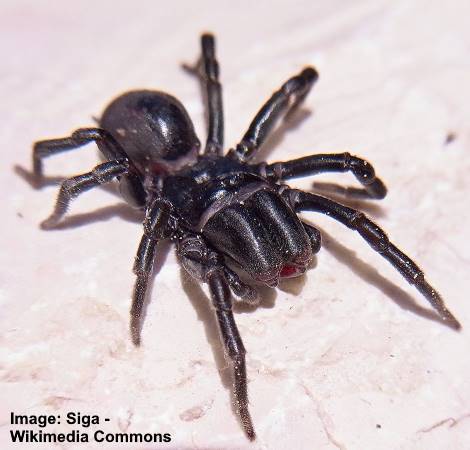
Purseweb Spider (Atypus affinis)
Purseweb spiders are small shiny brownish or black spiders that look like small tarantulas. Like black widows, purseweb spiders have shiny bodies. However, you can tell purseweb spiders apart from black widows because they don’t have red markings and are larger. The small black spider’s bite, however, is relatively harmless.
Purseweb spiders grow up to 0.6” (1.5 cm) long, with the males being somewhat smaller. The tiny black spiders are difficult to spot because they rarely enter homes and generally live under plant debris and fallen leaves.
Black spider identification: Purseweb spiders are identified by their shiny black body and fangs that point down. Purseweb spiders spin webs on the ground, and they cover them with leaves to trap prey.
Bold Jumping Spider (Phidippus audax)
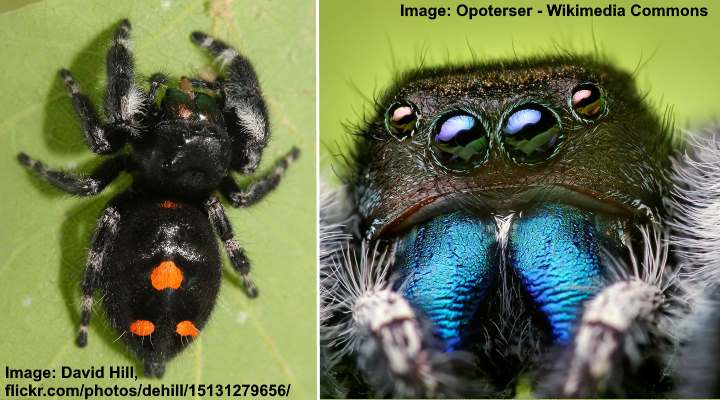
Bold Jumping Spider (Phidippus audax)
The bold jumping spider has a large round black abdomen with orange marking for juveniles that turn white as they mature and black furry legs with grayish bands. The identifying features of the black furry spiders are their iridescent mouthparts and flat face. Unlike most spiders, jumping spiders don’t use webs for catching prey; instead, they are predator spiders.
Bold jumping spiders are relatively large black spiders growing up to 0.7” (1.8 cm) long. Their striped legs are relatively short in comparison to their body. Sometimes bold jumping spiders enter homes and can be mistaken for brown recluse spiders.
Black spider identification: Bold jumping spiders have identifiable iridescent fangs, a fuzzy black or brown body, and adults have white marking on their backs.
Red-Backed Jumping Spider (Phidippus johnsoni)
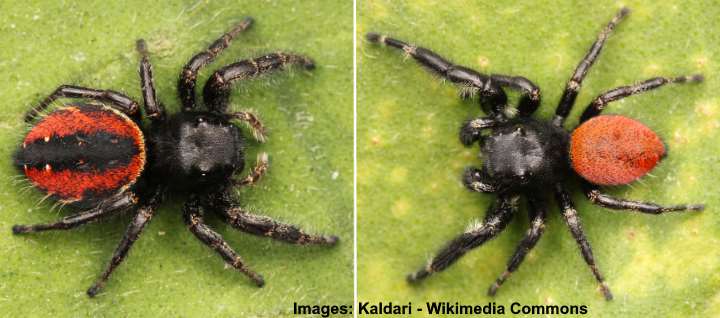
Red-Backed Jumping Spider (Phidippus johnsoni) female (left) and male (right)
The red-backed jumping spider is a harmless shiny black spider with black legs, a robust black cephalothorax, and a bright red abdomen. You can tell the males and females apart because females have a central black stripe on their red abdomen.
Compared to other jumping spiders, the red-backed jumping spider measures 0.5” (1.4 cm) long. Their legs are short and stumpy, and the leg span is slightly larger than its body size. As a type of preying spider, the redback jumpers don’t spin webs to catch prey.
Black spider identification: A redback jumping spider is easy to identify due to its contrasting jet-black cephalothorax and brightly colored red abdomen.
Zebra Jumping Spider (Salticus scenicus)
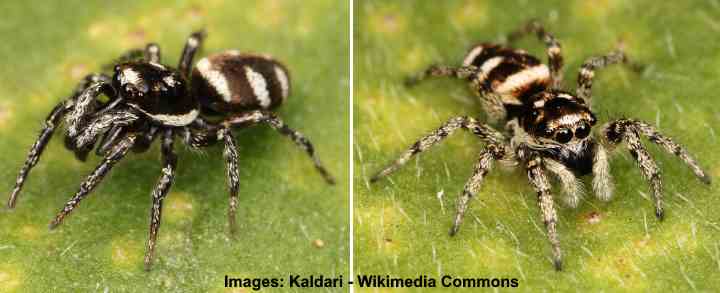
Zebra Jumping Spider (Salticus scenicus)
The zebra jumping spider is a spectacular furry black spider with white stripes. The tiny striped spiders have a fuzzy abdomen, spiny legs, and large eyes at the front of their body. The small zebra jumping spider gets its name from the black and white zebra-like patterns on its abdomen.
The zebra jumping spider doesn’t grow larger than 0.4” (1 cm) long. It hunts its prey by stalking and then pouncing on insects when close enough.
Black spider identification: The easily identifiable zebra jumping spider has a striking black furry abdomen with white stripes. Its black legs also have fine hairs and white markings.
Gray Wall Jumping Spider (Menemerus bivittatus)
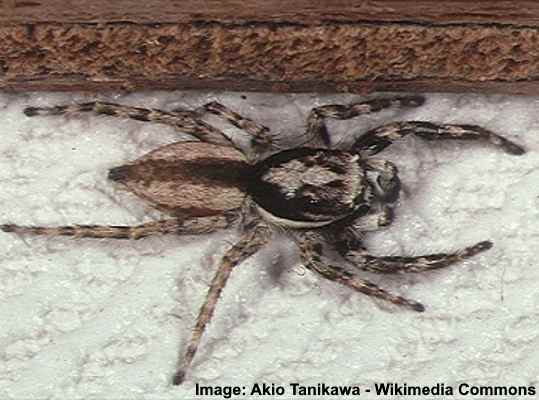
Gray Wall Jumping Spider (Menemerus bivittatus)
The gray wall jumping spider has a hairy body with black and gray stripes. Some species have a vivid white longitudinal stripe down the center of the body. Its abdomen is an egg shape, and the spider has eight fuzzy legs with spines.
The gray wall jumping spider grows up to 0.5” (1.2 cm) long. The grayish-black spiders are harmless to humans. However, when they feel threatened, the gray wall jumpers can bite, causing local pain.
Black spider identification: The gray wall jumping spider has identifiable contrasting gray and black stripes on a furry body.
Eastern Parson Spider (Herpyllus ecclesiasticus)

Eastern Parson Spider (Herpyllus ecclesiasticus)
The black parson spider is a medium-sized hairy spider with a black body, a white longitudinal band in the middle, and reddish-brown legs. The black furry spider measures between 0.4” and 0.8” (1 – 2 cm) long. Its harmless bite can cause an allergic reaction in some people.
You can find the predator spider lurking under logs, rocks, or debris in gardens. In addition, the medium-sized spider often enters homes when the weather gets colder.
Black spider identification: To identify the eastern parson spider, look for its long, black fuzzy body and grayish-white stripe along its cephalothorax and abdomen.
White-Tailed Spider (Lampona cylindrata)
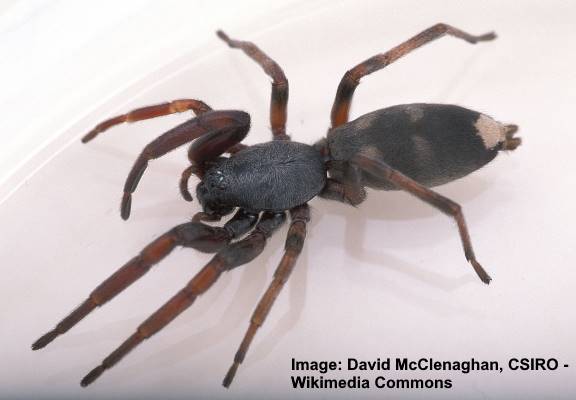
White-Tailed Spider (Lampona cylindrata)
The white-tailed spider has a slender blackish cephalothorax and abdomen with reddish-brown legs. The identifying trait of this spider is the white tip that most spiders in the species have on their abdomen. The brownish-black spider grows up to 0.7” (1.8 cm) long with a leg span of 1.2” (3 cm).
White-tailed spiders are native to Australia and live in gardens and houses. They often find shelter in dark places indoors and outdoors. The venomous spiders aren’t dangerous. However, their bite can cause itchiness, swelling, and pain.
Black spider identification: To identify the white-tailed spider, look for its blackish-brown slender, cigar-shaped body, tan or brown legs, and identifiable white tip on its abdomen.
Red and Black spider (Nicodamus peregrinus)
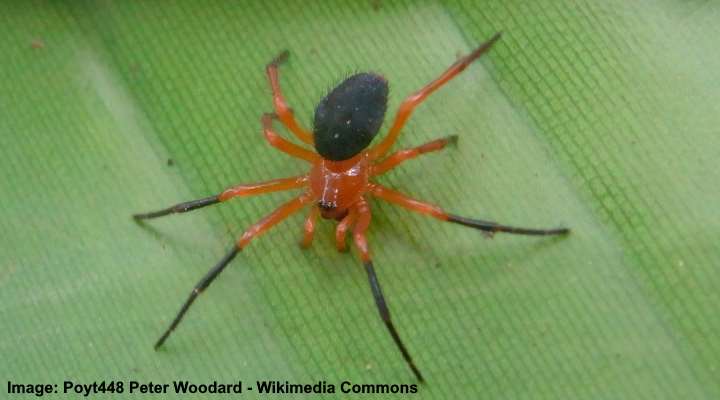
Red and Black spider (Nicodamus peregrinus)
The red and black spider has a black abdomen that contrasts with its coppery-red cephalothorax and red and black legs. In addition, this harmless spider has long legs, making it appear larger than it is. Females grow up to 0.5” (1.4 cm) long and males up to 0.4” (1 cm).
Red and black spiders are native to Australia. Although they have vibrant red coloring, it doesn’t indicate danger to humans.
Black spider identification: Red and black spiders have an easily recognizable coloration with red legs, red cephalothorax, and an egg-shaped black abdomen.
Spiny Orb-Weaver Spider (Gasteracantha cancriformis)

Spiny Orb-Weaver Spider (Gasteracantha cancriformis)
The spiny orb-weaver spider is a colorful black spider with a black-spotted abdomen and six spines. As one of the most unusual black spiders, the spiny orb-weaver has a brightly colored circular disc-like abdomen that can be red, yellow or white. Some species of these spiders have white upper-side with either red or black spines.
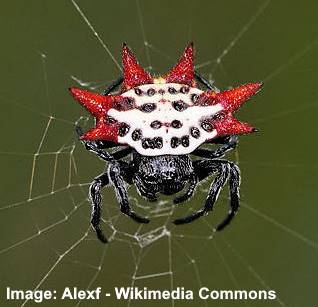
Spiny Orb-Weaver Spider
Spiny orb-weavers are relatively small, with females measuring 0.4” (1 cm) long and males a tiny 0.1” (0.3 cm). As the name suggests, the orb-weaver spiders spin giant webs to catch their prey.
Black spider identification: A spiny orb-weaver has an instantly recognizable white abdomen with black spots and six cone-like red spines. The spider’s cephalothorax is shiny black, and it has black legs.
Black and Yellow Garden Spider (Argiope aurantia)
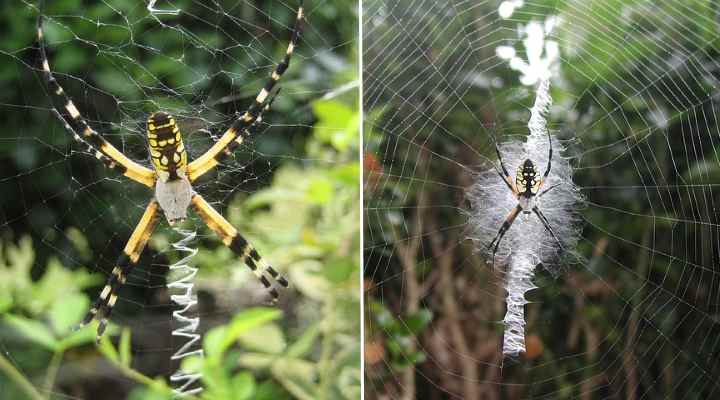
Black and Yellow Garden Spider (Argiope aurantia)
The black and yellow garden spider has an egg-shaped black abdomen with yellow markings and a white cephalothorax. In addition, the spider has an identifiable silhouette of an X shape or St Andrew’s cross. The garden orb spiders rarely bite and the pain is like a bee’s sting.
Other names for the black and yellow garden spider are zig-zag spider, golden garden spider, writing spider, and zipper spider. The spiders grow up to 1.1” (2.8 cm) with a considerable leg span of 2.5” (6.5 cm).
Black spider identification: Black and yellow spiders have a black body with bright yellow markings on the abdomen. Black and yellow garden spiders spin circular webs with a distinctive zig-zag pattern in the middle.
Wasp Spider (Argiope bruennichi)
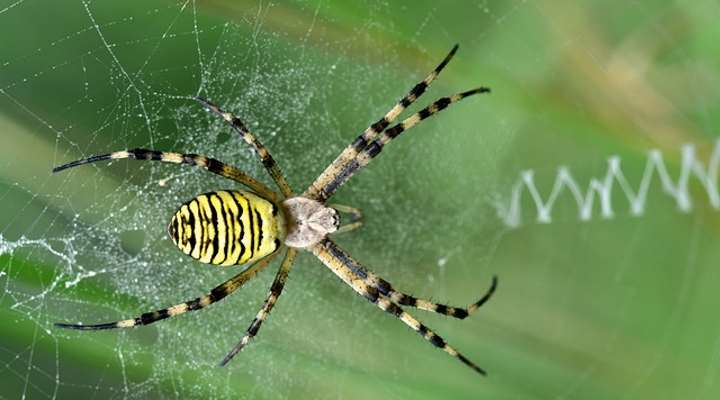
Wasp Spider (Argiope bruennichi)
The wasp spider is a striped yellow and black spider with a fuzzy white cephalothorax and black and yellow striped legs. The wasp spider is hard to differentiate from the yellow and black garden spider. Both have similar markings and spin large orb webs with a zig-zag pattern in the center.
The difference between wasp spiders and garden spiders is that wasp spiders have a stripy body, just like a wasp.
The wasp spider has long, straight legs like all spiders in the genus Argiope. However, like St Andrew’s cross spiders, the spider has a distinctive X shape as it rests two pairs of legs on the other two pairs.
Female wasp spiders grow up to 0.6” (1.5 cm) long, and males are smaller at 0.15” (0.4 cm) long.
Black spider identification: To identify a wasp spider, look for its characteristic black, yellow, and white bands around its abdomen. The long spindly legs have yellow and black bands.
Salticus palpalis
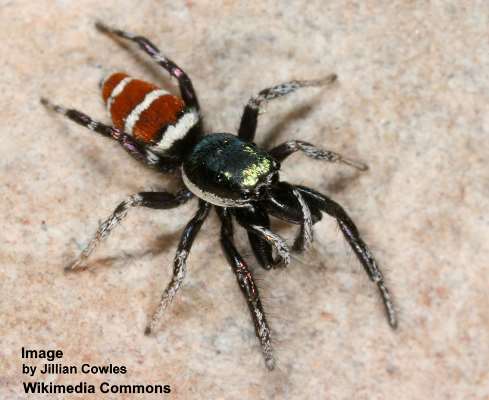
Salticus palpalis (male)
Salticus palpalis is a type of tiny furry black zebra spider with jumping capabilities. The fascinating black spider has an iridescent cephalothorax with shimmering green colors. The spider has eight black furry legs with white markings and black spines. The furry abdomen is a copper-red color with white bands.
Female zebra spiders are entirely black with white abdominal bands. Salticus palpalis spiders only measure 0.2” (0.5 cm) in length.
Black spider identification: To identify the Salticus palpalis black spider, look for the greenish-black shimmery cephalothorax and furry abdomen with thick white stripes wrapping around it.
Noble False Widow (Steatoda nobilis)
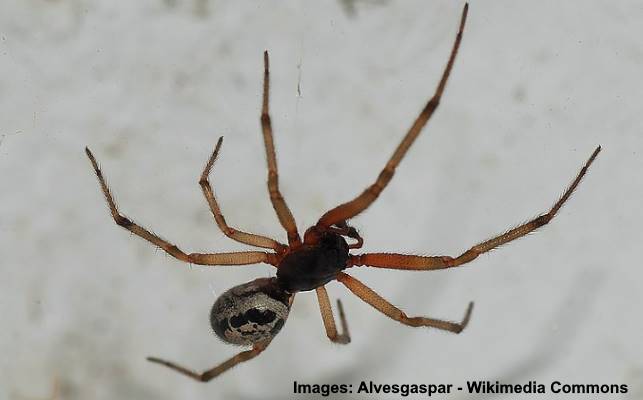
Noble False Widow (Steatoda nobilis)
The noble false widow is a small brownish-black spider that is easy to confuse for a black widow. The black spider has a blackish-brown cephalothorax and gray bulbous abdomen with black markings. The identifying characteristic of this spindly spider is its reddish-orange legs.
In many countries, the noble false widow is an invasive species of spider. It can invade homes in urban environments, and its population can expand rapidly.
Like the black widow spider, the false noble widow can inflict a nasty bite. The venomous spider bite can cause intense pain. It is considered one of the most dangerous spiders in Europe.
Black spider identification: The noble false widow has recognizable long brown legs attached to a brownish-black bulbous body.
Spotted Orb-Weavers (Neoscona)
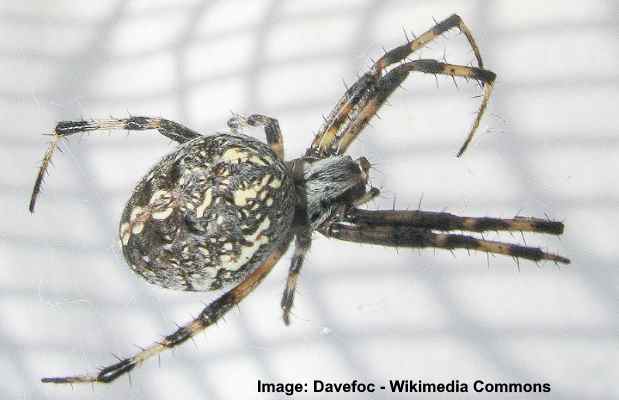
Spotted Orb-Weavers (Neoscona oaxacensis)
Spotted orb-weaver spiders—also called barn spiders—have a bulbous dark gray or brown body with random creamy-yellow markings and spiny banded legs. The grayish-black spiders grow up to 0.8” (2 cm) and have long legs compared to their bodies. The spotted orb-weavers can bite, but they don’t cause any severe outcomes in humans.
Black spider identification: Spotted orb weavers have characteristic wavy yellow or white markings on ball-like black or brown body.
Learn how to identify many types of brown spiders.
Related articles:
